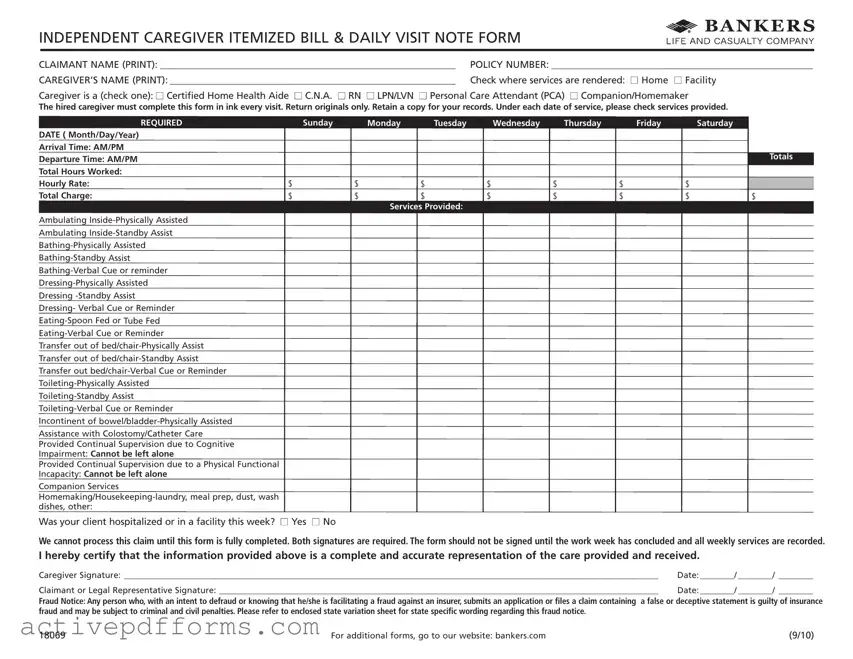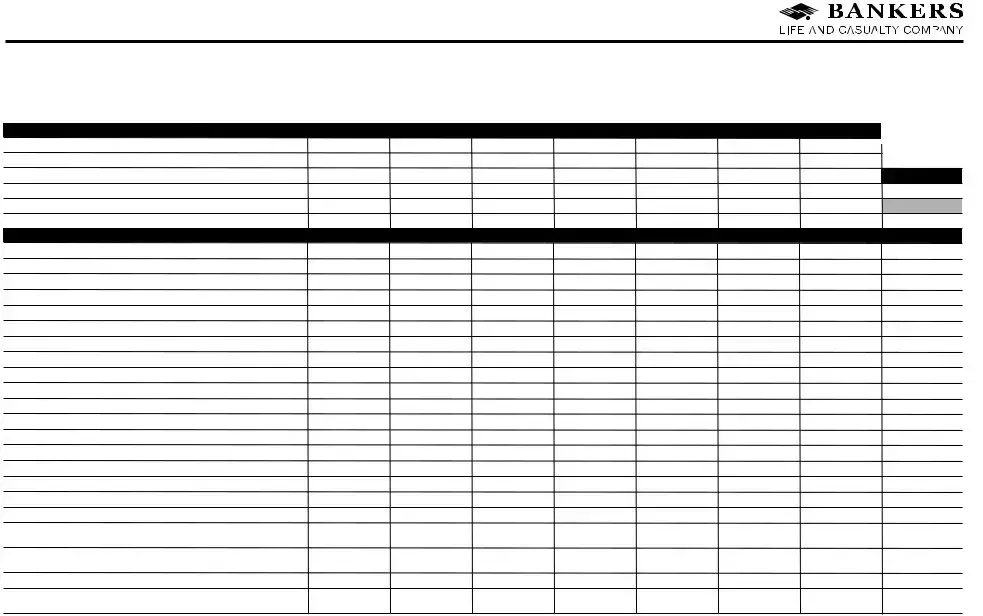INDEPENDENT CAREGIVER ITEMIZED BILL & DAILY VISIT NOTE FORM
CLAIMANT NAME (PRINT): _____________________________________________________________ |
POLICY NUMBER: ______________________________________________________ |
CAREGIVER’S NAME (PRINT): ___________________________________________________________ |
Check where services are rendered: n Home n Facility |
Caregiver is a (check one): n Certified Home Health Aide n C.N.A. n RN n LPN/LVN n Personal Care Attendant (PCA) n Companion/Homemaker
The hired caregiver must complete this form in ink every visit. Return originals only. Retain a copy for your records. Under each date of service, please check services provided.
REQUIRED
DATE ( Month/Day/Year)
Arrival Time: AM/PM
Departure Time: AM/PM
Total Hours Worked:
Hourly Rate:
Total Charge:
Sunday |
Monday |
Tuesday |
Wednesday |
Thursday |
Friday |
Saturday |
|
|
|
|
|
|
|
Totals |
$ |
$ |
$ |
$ |
$ |
$ |
$ |
|
$ |
$ |
$ |
$ |
$ |
$ |
$ |
$ |
|
|
Services Provided: |
|
|
|
|
|
Ambulating Inside-Physically Assisted Ambulating Inside-Standby Assist Bathing-Physically Assisted Bathing-Standby Assist Bathing-Verbal Cue or reminder Dressing-Physically Assisted Dressing -Standby Assist Dressing- Verbal Cue or Reminder Eating-Spoon Fed or Tube Fed Eating-Verbal Cue or Reminder Transfer out of bed/chair-Physically Assist Transfer out of bed/chair-Standby Assist Transfer out bed/chair-Verbal Cue or Reminder Toileting-Physically Assisted Toileting-Standby Assist Toileting-Verbal Cue or Reminder Incontinent of bowel/bladder-Physically Assisted
Assistance with Colostomy/Catheter Care Provided Continual Supervision due to Cognitive Impairment: Cannot be left alone Provided Continual Supervision due to a Physical Functional Incapacity: Cannot be left alone
Companion Services Homemaking/Housekeeping-laundry, dishes, other:
Was your client hospitalized or in a facility this week? n Yes n No
We cannot process this claim until this form is fully completed. Both signatures are required. The form should not be signed until the work week has concluded and all weekly services are recorded.
I hereby certify that the information provided above is a complete and accurate representation of the care provided and received.
Caregiver Signature: ____________________________________________________________________________________________________________________________ |
Date: ________/ ________/ |
________ |
Claimant or Legal Representative Signature: ______________________________________________________________________________________________________ |
Date: ________/ ________/ |
________ |
Fraud Notice: Any person who, with an intent to defraud or knowing that he/she is facilitating a fraud against an insurer, submits an application or files a claim containing a false or deceptive statement is guilty of insurance fraud and may be subject to criminal and civil penalties. Please refer to enclosed state variation sheet for state specific wording regarding this fraud notice.
18069 |
For additional forms, go to our website: bankers.com |
(9/10) |

